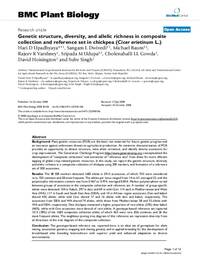Genetic structure, diversity, and allelic richness in composite collection and reference set in chickpea (Cicer arietinum L.)

Authors:
Background: Plant genetic resources (PGR) are the basic raw materials for future genetic progress and an insurance against unforeseen threats to agricultural production. An extensive characterization of PGR provides an opportunity to dissect structure, mine allelic variations, and identify diverse accessions for crop improvement. The Generation Challenge Program http://www.generationcp.org conceptualized the development of composite collections and extraction of reference sets from these for more efficient tapping of global crop-related genetic resources. In this study, we report the genetic structure, diversity and allelic richness in a composite collection of chickpea using SSR markers, and formation of a reference set of 300 accessions. Results: The 48 SSR markers detected 1683 alleles in 2915 accessions, of which, 935 were considered rare, 720 common and 28 most frequent. The alleles per locus ranged from 14 to 67, averaged 35, and the polymorphic information content was from 0.467 to 0.974, averaged 0.854. Marker polymorphism varied between groups of accessions in the composite collection and reference set. A number of group-specific alleles were detected: 104 in Kabuli, 297 in desi, and 69 in wild Cicer; 114 each in Mediterranean and West Asia (WA), 117 in South and South East Asia (SSEA), and 10 in African region accessions. Desi and kabuli shared 436 alleles, while wild Cicer shared 17 and 16 alleles with desi and kabuli, respectively. The accessions from SSEA and WA shared 74 alleles, while those from Mediterranean 38 and 33 alleles with WA and SSEA, respectively. Desi chickpea contained a higher proportion of rare alleles (53%) than kabuli (46%), while wild Cicer accessions were devoid of rare alleles. A genotype-based reference set captured 1315 (78%) of the 1683 composite collection alleles of which 463 were rare, 826 common, and 26 the most frequent alleles. The neighbour-joining tree diagram of this reference set represents diversity from all directions of the tree diagram of the composite collection. Conclusion: The genotype-based reference set, reported here, is an ideal set of germplasm for allele mining, association genetics, mapping and cloning gene(s), and in applied breeding for the development of broad-based elite breeding lines/cultivars with superior yield and enhanced adaptation to diverse environments.
